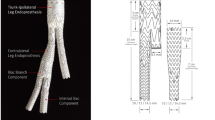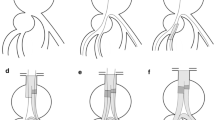Abstract
Objectives
To prevent buttock claudication, we performed endovascular aortic aneurysm repair (EVAR) for isolated internal iliac aneurysms (IIAAs) with selective preservation of the superior gluteal artery (SGA) flow. This study evaluates early clinical outcomes of this treatment.
Methods and results
We retrospectively evaluated 6 patients with isolated IIAA who underwent EVAR under local anesthesia between October 2017 and July 2018 at Tokyo Women’s Medical University Hospital. We used self-expanding stent grafts to exclude the IIAA while preserving SGA flow. If necessary, we occluded the inferior gluteal artery and other branches with vascular plugs to prevent type II endoleak. The mean proximal neck diameter and length of the IIAAs to be 9.4 ± 2.4 mm and 17.7 ± 11.3 mm. The mean diameter of the SGA was 6.5 ± 0.9 mm. There were no procedural complications, and the mean procedure time was 84 ± 24 min. All patients were free from buttock claudication at follow-up. Postoperative computed tomography demonstrated a 100% primary patency rate of the SGA stent graft: there was no case of migration or endoleak.
Conclusion
EVAR for IIAAs with SGA flow preservation shows favorable early clinical outcomes. To prevent buttock claudication, SGA flow is necessary and sufficient. This novel approach is less invasive compared to conventional IIAA repair.



Similar content being viewed by others
References
Krupski WC, Selzman CH, Floridia R, Strecker PK, Nehler MR, Whitehill TA. Contemporary management of isolated iliac aneurysms. J Vasc Surg. 1998;28:1–11.
Brunkwall J, Hauksson H, Bengtsson H, Bergqvist D, Takolander R, Bergentz SE. Solitary aneurysms of the iliac arterial system: an estimate of their frequency of occurrence. J Vasc Surg. 1989;10:381–4.
Dix FP, Titi M, Al-Khaffaf H. The isolated internal iliac artery aneurysm—a review. Eur J Vasc Endovasc Surg. 2005;30:119–29.
Richardson JW, Greenfield LJ. Natural history and management of iliac aneurysms. J Vasc Surg. 1988;8:165–71.
Patel NV, Long GW, Cheema ZF, Rimar K, Brown OW, Shanley CJ. Open vs. endovascular repair of isolated iliac artery aneurysms: a 12-year experience. J Vasc Surg. 2009;49:1147–53.
Rayt HS, Bown MJ, Lambert KV, Fishwick NG, McCarthy MJ, London NJ, et al. Buttock claudication and erectile dysfunction after internal iliac artery embolization in patients prior to endovascular aortic aneurysm repair. Cardiovasc Intervent Radiol. 2008;31:728–34.
Choi HR, Park KH, Lee JH. Risk Factor analysis for buttock claudication after internal iliac artery embolization with endovascular aortic aneurysm repair. Vasc Spec Int. 2016;32:44–50.
Su WT, Stone DH, Lamparello PJ, Rockman CB. Gluteal compartment syndrome following elective unilateral internal iliac artery embolization before endovascular abdominal aortic aneurysm repair. J Vasc Surg. 2004;39:672–5.
Björck M, Troëng T, Bergqvist D. Risk factors for intestinal ischaemia after aortoiliac surgery: a combined cohort and case-control study of 2824 operations. Eur J Vasc Endovasc Surg. 1997;13:531–9.
Kritpracha B, Comerota AJ. Unilateral lower extremity paralysis after coil embolization of an internal iliac artery aneurysm. J Vasc Surg. 2004;40:819–21.
Muradi A, Yamaguchi M, Okada T, Nomura Y, Idoguchi K, Ueshima E, et al. Technical and outcome considerations of endovascular treatment for internal iliac artery aneurysms. Cardiovasc Intervent Radiol. 2014;37:348–54.
Millon A, Paquet Y, Ahmed SB, Pinel G, Rosset E, Lermusiaux P. Midterm outcomes of embolisation of internal iliac artery aneurysms. Eur J Vasc Endovasc Surg. 2013;45:22 – 7.
Warein E, Feugier P, Chaufour X, Molin V, Malikov S, Bartoli MA, et al. Amplatzer plug to occlude the internal iliac artery during endovascular aortic aneurysm repair: a large multicenter study. Eur J Vasc Endovasc Surg. 2016;51:641–6.
Burbelko M, Kalinowski M, Heverhagen JT, Piechowiak E, Kiessling A, Figiel J, et al. Prevention of type II endoleak using the AMPLATZER vascular plug before endovascular aneurysm repair. Eur J Vasc Endovasc Surg. 2014;47:28–36.
Ha CD, Calcagno D. Amplatzer vascular plug to occlude the internal iliac arteries in patients undergoing aortoiliac aneurysm repair. J Vasc Surg. 2005;42:1058–62.
Batt M, Baqué J, Ajmia F, Cavalier M. Angioplasty of the superior gluteal artery in 34 patients with buttock claudication. J Endovasc Ther 2014;21:400–6.
Lobato AC, Camacho-Lobato L. The sandwich technique to treat complex aortoiliac or isolated iliac aneurysms: results of midterm follow-up. J Vasc Surg. 2013;57:26S–34S.
Smith MT, Gupta R, Jazaeri Omid J, Rochon P, Ray CE Jr. Preservation of internal iliac arterial flow during endovascular aortic aneurysm repair using the “sandwich” technique. Semin Intervent Radiol. 2013;30:82–6.
Ullery BW, Tran K, Itoga N, Casey K, Dalman RL, Lee JT. Safety and efficacy of antiplatelet/anticoagulation regimens after Viabahn stent graft treatment for femoropopliteal occlusive disease. J Vasc Surg. 2015;61:1479–88.
Chun JY, Mailli L, Abbasi MI, Belli AM, Gonsalves M, Munneke G, et al. Embolization of the internal iliac artery before EVAR: is it effective? Is it safe? Which technique should be used? Cardiovasc Intervent Radiol. 2014;37:329–36.
Meller SM, Stilp E, Walker CN, Mena-Hurtado C. The link between vasculogenic erectile dysfunction, coronary artery disease, and peripheral artery disease: role of metabolic factors and endovascular therapy. J Invasive Cardiol. 2013;25:313–9.
Author information
Authors and Affiliations
Corresponding author
Ethics declarations
Conflict of interest
The authors declare that they have no conflicts of interest.
Additional information
Publisher’s Note
Springer Nature remains neutral with regard to jurisdictional claims in published maps and institutional affiliations.
Rights and permissions
About this article
Cite this article
Domoto, S., Azuma, T., Yokoi, Y. et al. Minimally invasive treatment for isolated internal iliac artery aneurysms preserving superior gluteal artery flow. Gen Thorac Cardiovasc Surg 67, 835–840 (2019). https://doi.org/10.1007/s11748-019-01096-5
Received:
Accepted:
Published:
Issue Date:
DOI: https://doi.org/10.1007/s11748-019-01096-5




